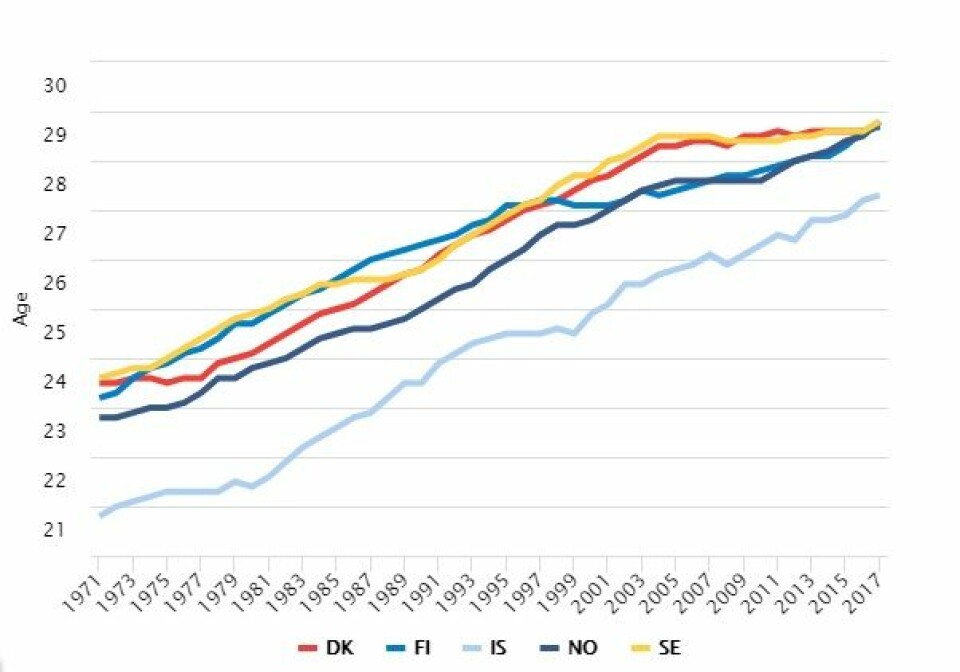
Record low fertility rates in Norway, Finland and Iceland
Never before has each woman given birth to so few children in these three Nordic countries.
“We’re heading towards a situation like in China – even without a one-child policy,” says Anna Karlsdóttir in a press release.
She is a researcher for NordRegio, the Nordic Council of Ministers' research centre for regional development and planning.
Karlsdóttir is one of the authors of a new Nordic report. The research includs studies of population development in all municipalities and regions in the Nordic countries.
The Nordic countries have previously had high fertility rates. This has been partly explained by the fact that the countries have favourable policies for parental leave and childcare.
Now these policies don’t seem to be having as much effect as one would expect, Karlsdóttir says. “We’re becoming more and more like the rest of the world.”
Fertility rates have gone down in almost the entire Nordic region.
Even Greenland, which has usually had high fertility rates, has seen a decline. The fertility rate there now averages 2.0 births per woman.
Finland has the lowest fertility rate
Finland has seen the largest drop in fertility rates. The country’s average fertility rate is now 1.4 births per woman, compared to 1.9 in 2010.
Norway is just behind at 1.56 children, compared with 1.96 in 2010.
Finland’s and Norway’s fertility rates are now lower than the EU average, which is at 1,59.
Thanks to Sweden and Denmark, which still have relatively high fertility rates, the Nordic region as a whole is slightly above the EU average.
Sweden’s fertility rate is 1.76 children born per woman and Denmark’s is 1.72.
Regional variations
The researchers found regional fertility rate variations within countries. Some Sami societies in Northern Sweden have higher fertility rates.
In Norway, the researchers observed that higher fertility rates in Granvin municipality in Vestlandet county and in the municipalities of Snillfjord, Tydal, Åfjord and Roan in Trøndelag county also stand out.
The report notes that regional differences are also striking in Finland.
Having first child later
The researchers' main explanation for this development is that women are having their first child later in life.
Today, the average age of first-time mothers in the Nordic countries is 30 years old compared to age 21 in 1971.
The number of first-time mothers under age 25 has decreased throughout the Nordic region, while the number of those above 35 has increased.
“Family planning is mostly a positive thing. The children are wanted and welcomed. But unfortunately, fertility is an issue when delaying childbirth until women are older,” says Karlsdóttir.
The age when a woman has her first child has gone up in Denmark (DK), Finland (FI), Iceland (IS), Norway (NO) and Sweden (SE).

Researchers missed the mark
Astri Syse, a researcher at Statistics Norway, recently admitted to forskning.no that the agency miscalculated projections of women's fertility rates.
The decline in the number of newborns in Norway is greater and more dramatic than population researchers announced a few years ago.
Researchers are now working on models that can better project fertility rates. They are seeing that many countries have experienced more deviations than the researchers could have foreseen.
Norwegian women need to give birth to 2.1 children, knows as 'the replacement rate', each to maintain the population.
Less immigration
Statistics Norway has also overestimated how many immigrants will come to Norway, Syse says.
These two factors – reduced immigration and reduced fertility – together result in a steeper ageing curve than scientists anticipated a few years ago.
This immigration trend particularly affects more rural parts of the country.
Many of the immigrants who settled in rural Norway a few years ago are from Eastern Europe. In the coming years, some Eastern European countries like Poland and Lithuania will also be facing a shortage of young people. The researchers believe that will result in fewer immigrants coming to Norway in the future.
Today, Syrians are the only immigrant group contributing somewhat to slowing down the proportion of the ageing population in rural areas, say the researchers.
The researchers behind the report to the Nordic Council believe that successfully integrating immigrants will be crucial to reverse the flight trend in rural areas in the Nordic countries.
They found that 26 per cent of all Nordic municipalities experienced population growth due to immigration. Many of these municipalities previously suffered from rural flight, an ageing population and reduced services.
Young people leave
Another reason why rural areas are particularly hard hit by the decline in birth rates is that their young people are moving away.
While the proportion of 20 to 29 year olds has increased by 47 per cent in Nordic cities over the past 19 years, the countryside has seen a 54 per cent decline in young people, according to the Nordic report.
This population shift is also very prevalent in Norway.
Several Norwegian municipalities have lost more than 30 per cent of their youth since 2000. Loppa municipality in Finnmark county has lost 44 per cent and Beiarn municipality in Nordland county 37 per cent of their young people.
The situation in Finland is even more dramatic. It is not uncommon for 40 to 60 per cent of the young people in rural areas to leave their small towns.
This article was changed on 24th feb at 09:34 to replace the term birth rate with fertility rate. The heading was changed from 'record low birth rates' to 'record low fertility rates'.
Reference:
Anna Karlsdóttir and others: State of the Nordic Region 2020, Nordic Council of Ministers
———
Translated by: Ingrid P. Nuse
Read the Norwegian version of this article on forskning.no
































